Nursing 7 Assignment: Medications, Antibiotics, and Nursing Roles
VerifiedAdded on 2020/02/18
|9
|2365
|113
Report
AI Summary
This nursing assignment examines the risks associated with acetaminophen and ibuprofen, detailing potential adverse effects such as liver damage and allergic reactions, while also outlining the benefits of regular antibiotic use in treating infections. The report emphasizes the importance of comprehensive nursing assessments, including monitoring vital signs, lab results, and patient history, to mitigate risks and ensure safe medication administration. Furthermore, it explores the role of nurses in adhering to quality use of medicines to prevent antimicrobial resistance, highlighting the need for antimicrobial stewardship, monitoring antibiotic use, and effective communication with patients and healthcare teams. The assignment underscores the challenges nurses face and the importance of their contributions in promoting safe and effective medication practices within clinical settings.
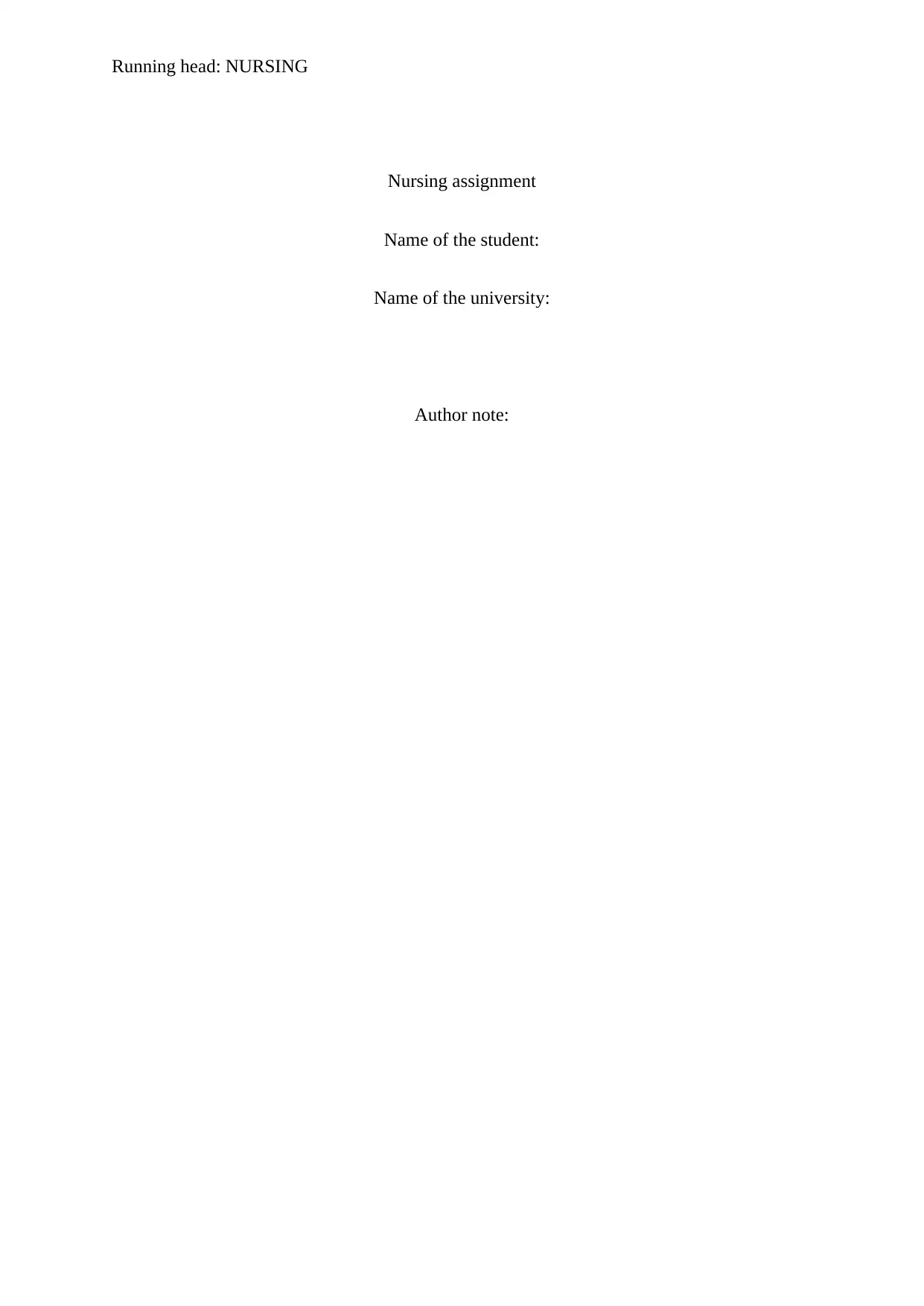
Running head: NURSING
Nursing assignment
Name of the student:
Name of the university:
Author note:
Nursing assignment
Name of the student:
Name of the university:
Author note:
Paraphrase This Document
Need a fresh take? Get an instant paraphrase of this document with our AI Paraphraser
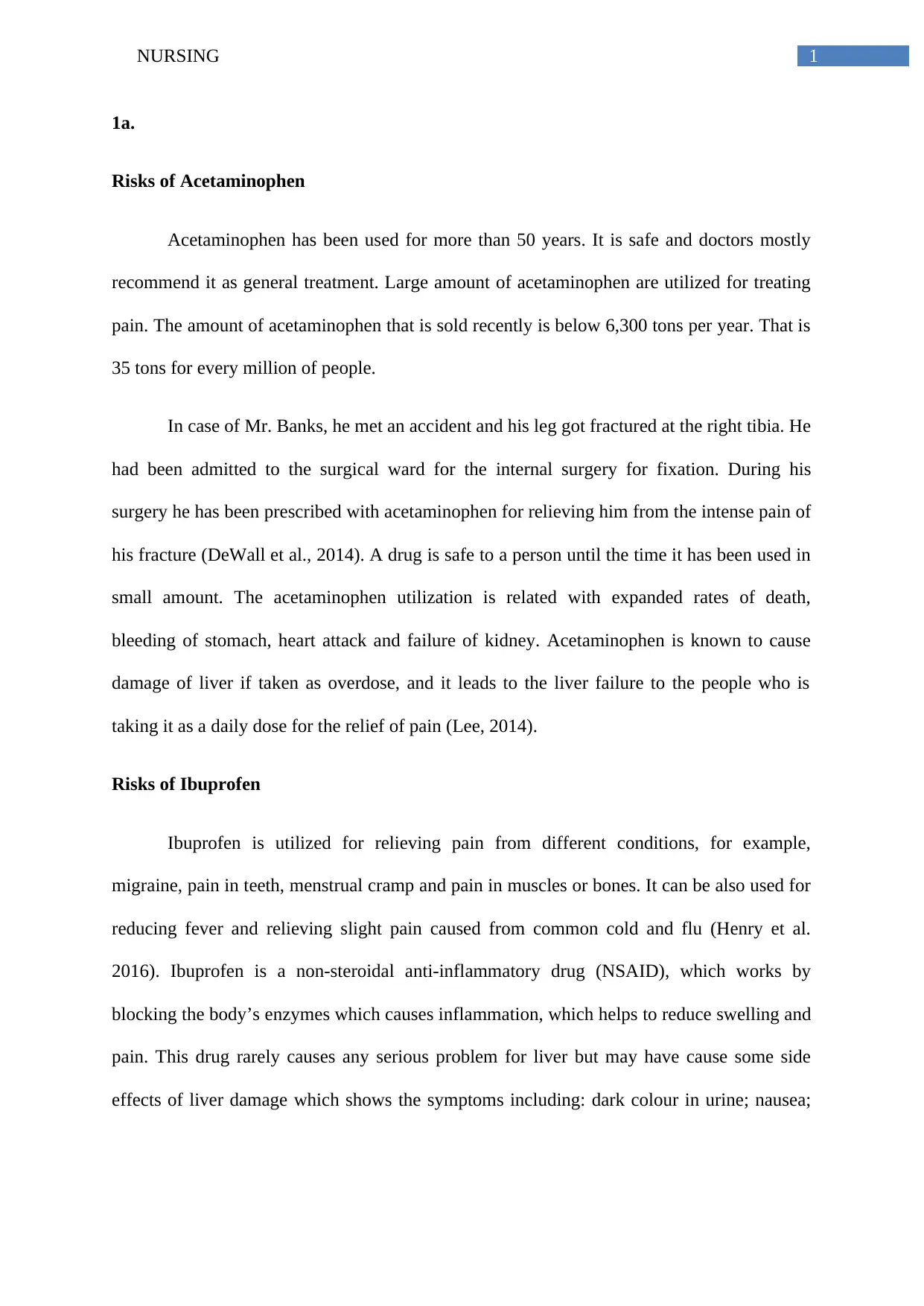
1NURSING
1a.
Risks of Acetaminophen
Acetaminophen has been used for more than 50 years. It is safe and doctors mostly
recommend it as general treatment. Large amount of acetaminophen are utilized for treating
pain. The amount of acetaminophen that is sold recently is below 6,300 tons per year. That is
35 tons for every million of people.
In case of Mr. Banks, he met an accident and his leg got fractured at the right tibia. He
had been admitted to the surgical ward for the internal surgery for fixation. During his
surgery he has been prescribed with acetaminophen for relieving him from the intense pain of
his fracture (DeWall et al., 2014). A drug is safe to a person until the time it has been used in
small amount. The acetaminophen utilization is related with expanded rates of death,
bleeding of stomach, heart attack and failure of kidney. Acetaminophen is known to cause
damage of liver if taken as overdose, and it leads to the liver failure to the people who is
taking it as a daily dose for the relief of pain (Lee, 2014).
Risks of Ibuprofen
Ibuprofen is utilized for relieving pain from different conditions, for example,
migraine, pain in teeth, menstrual cramp and pain in muscles or bones. It can be also used for
reducing fever and relieving slight pain caused from common cold and flu (Henry et al.
2016). Ibuprofen is a non-steroidal anti-inflammatory drug (NSAID), which works by
blocking the body’s enzymes which causes inflammation, which helps to reduce swelling and
pain. This drug rarely causes any serious problem for liver but may have cause some side
effects of liver damage which shows the symptoms including: dark colour in urine; nausea;
1a.
Risks of Acetaminophen
Acetaminophen has been used for more than 50 years. It is safe and doctors mostly
recommend it as general treatment. Large amount of acetaminophen are utilized for treating
pain. The amount of acetaminophen that is sold recently is below 6,300 tons per year. That is
35 tons for every million of people.
In case of Mr. Banks, he met an accident and his leg got fractured at the right tibia. He
had been admitted to the surgical ward for the internal surgery for fixation. During his
surgery he has been prescribed with acetaminophen for relieving him from the intense pain of
his fracture (DeWall et al., 2014). A drug is safe to a person until the time it has been used in
small amount. The acetaminophen utilization is related with expanded rates of death,
bleeding of stomach, heart attack and failure of kidney. Acetaminophen is known to cause
damage of liver if taken as overdose, and it leads to the liver failure to the people who is
taking it as a daily dose for the relief of pain (Lee, 2014).
Risks of Ibuprofen
Ibuprofen is utilized for relieving pain from different conditions, for example,
migraine, pain in teeth, menstrual cramp and pain in muscles or bones. It can be also used for
reducing fever and relieving slight pain caused from common cold and flu (Henry et al.
2016). Ibuprofen is a non-steroidal anti-inflammatory drug (NSAID), which works by
blocking the body’s enzymes which causes inflammation, which helps to reduce swelling and
pain. This drug rarely causes any serious problem for liver but may have cause some side
effects of liver damage which shows the symptoms including: dark colour in urine; nausea;
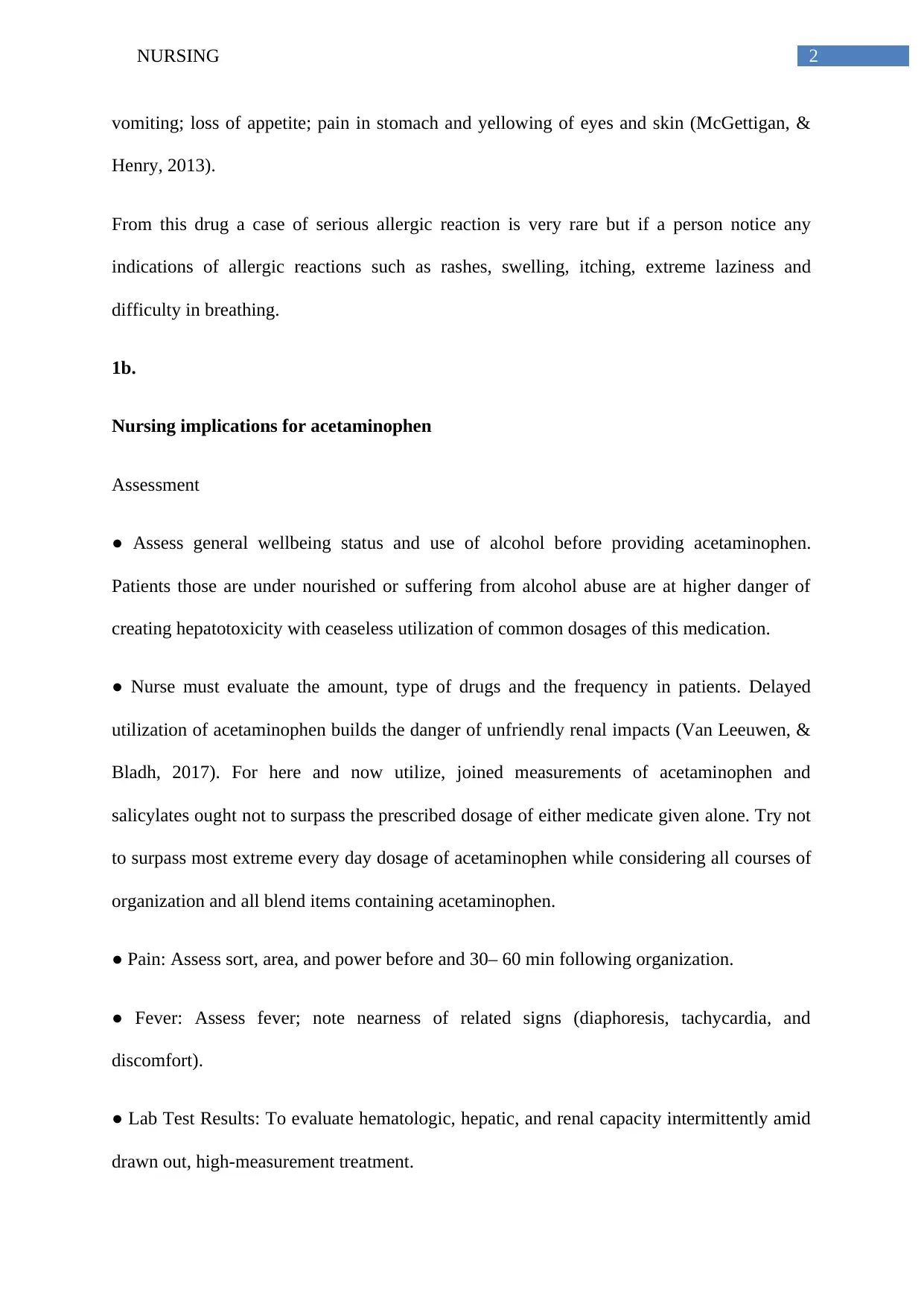
2NURSING
vomiting; loss of appetite; pain in stomach and yellowing of eyes and skin (McGettigan, &
Henry, 2013).
From this drug a case of serious allergic reaction is very rare but if a person notice any
indications of allergic reactions such as rashes, swelling, itching, extreme laziness and
difficulty in breathing.
1b.
Nursing implications for acetaminophen
Assessment
● Assess general wellbeing status and use of alcohol before providing acetaminophen.
Patients those are under nourished or suffering from alcohol abuse are at higher danger of
creating hepatotoxicity with ceaseless utilization of common dosages of this medication.
● Nurse must evaluate the amount, type of drugs and the frequency in patients. Delayed
utilization of acetaminophen builds the danger of unfriendly renal impacts (Van Leeuwen, &
Bladh, 2017). For here and now utilize, joined measurements of acetaminophen and
salicylates ought not to surpass the prescribed dosage of either medicate given alone. Try not
to surpass most extreme every day dosage of acetaminophen while considering all courses of
organization and all blend items containing acetaminophen.
● Pain: Assess sort, area, and power before and 30– 60 min following organization.
● Fever: Assess fever; note nearness of related signs (diaphoresis, tachycardia, and
discomfort).
● Lab Test Results: To evaluate hematologic, hepatic, and renal capacity intermittently amid
drawn out, high-measurement treatment.
vomiting; loss of appetite; pain in stomach and yellowing of eyes and skin (McGettigan, &
Henry, 2013).
From this drug a case of serious allergic reaction is very rare but if a person notice any
indications of allergic reactions such as rashes, swelling, itching, extreme laziness and
difficulty in breathing.
1b.
Nursing implications for acetaminophen
Assessment
● Assess general wellbeing status and use of alcohol before providing acetaminophen.
Patients those are under nourished or suffering from alcohol abuse are at higher danger of
creating hepatotoxicity with ceaseless utilization of common dosages of this medication.
● Nurse must evaluate the amount, type of drugs and the frequency in patients. Delayed
utilization of acetaminophen builds the danger of unfriendly renal impacts (Van Leeuwen, &
Bladh, 2017). For here and now utilize, joined measurements of acetaminophen and
salicylates ought not to surpass the prescribed dosage of either medicate given alone. Try not
to surpass most extreme every day dosage of acetaminophen while considering all courses of
organization and all blend items containing acetaminophen.
● Pain: Assess sort, area, and power before and 30– 60 min following organization.
● Fever: Assess fever; note nearness of related signs (diaphoresis, tachycardia, and
discomfort).
● Lab Test Results: To evaluate hematologic, hepatic, and renal capacity intermittently amid
drawn out, high-measurement treatment.
⊘ This is a preview!⊘
Do you want full access?
Subscribe today to unlock all pages.

Trusted by 1+ million students worldwide
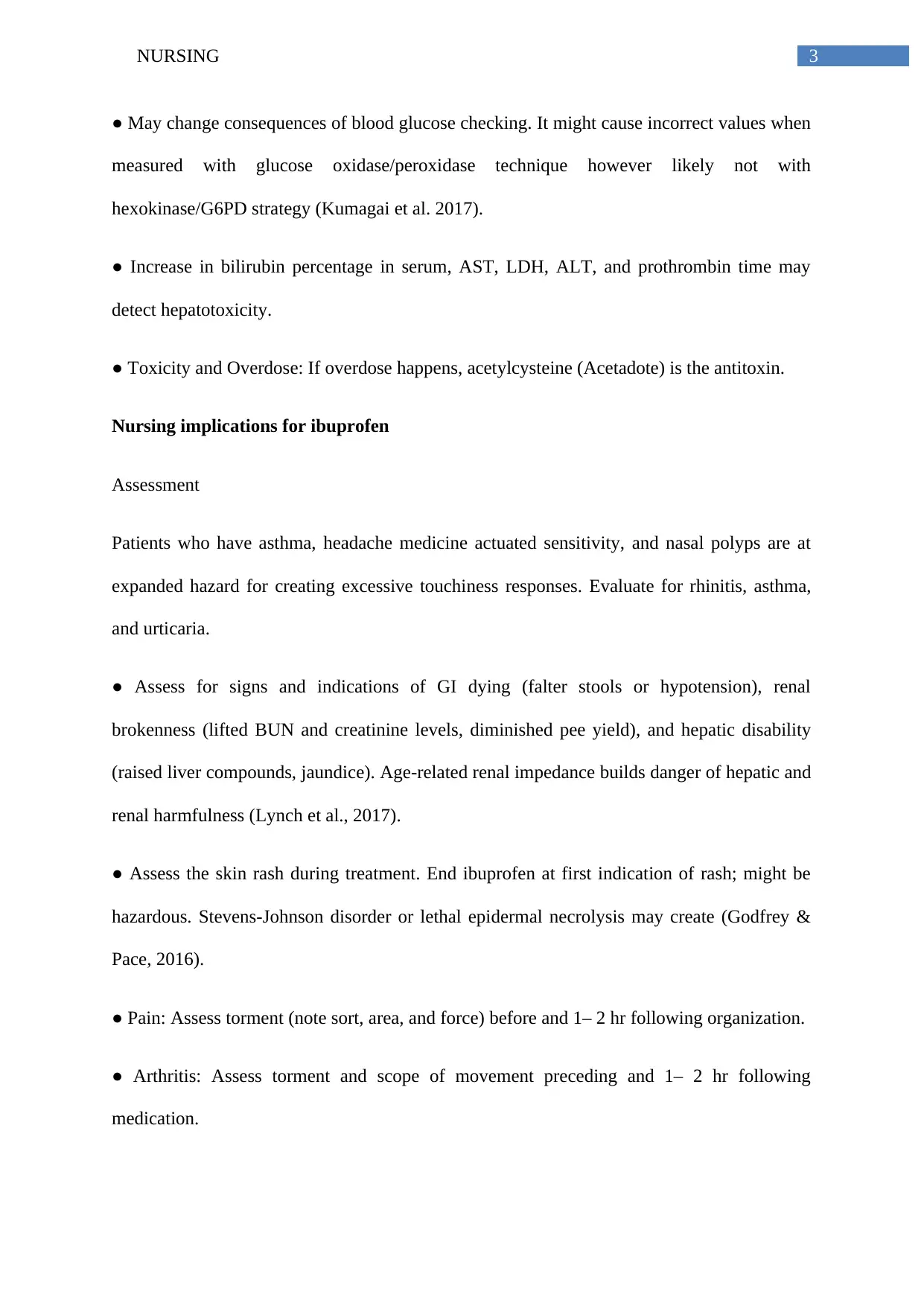
3NURSING
● May change consequences of blood glucose checking. It might cause incorrect values when
measured with glucose oxidase/peroxidase technique however likely not with
hexokinase/G6PD strategy (Kumagai et al. 2017).
● Increase in bilirubin percentage in serum, AST, LDH, ALT, and prothrombin time may
detect hepatotoxicity.
● Toxicity and Overdose: If overdose happens, acetylcysteine (Acetadote) is the antitoxin.
Nursing implications for ibuprofen
Assessment
Patients who have asthma, headache medicine actuated sensitivity, and nasal polyps are at
expanded hazard for creating excessive touchiness responses. Evaluate for rhinitis, asthma,
and urticaria.
● Assess for signs and indications of GI dying (falter stools or hypotension), renal
brokenness (lifted BUN and creatinine levels, diminished pee yield), and hepatic disability
(raised liver compounds, jaundice). Age-related renal impedance builds danger of hepatic and
renal harmfulness (Lynch et al., 2017).
● Assess the skin rash during treatment. End ibuprofen at first indication of rash; might be
hazardous. Stevens-Johnson disorder or lethal epidermal necrolysis may create (Godfrey &
Pace, 2016).
● Pain: Assess torment (note sort, area, and force) before and 1– 2 hr following organization.
● Arthritis: Assess torment and scope of movement preceding and 1– 2 hr following
medication.
● May change consequences of blood glucose checking. It might cause incorrect values when
measured with glucose oxidase/peroxidase technique however likely not with
hexokinase/G6PD strategy (Kumagai et al. 2017).
● Increase in bilirubin percentage in serum, AST, LDH, ALT, and prothrombin time may
detect hepatotoxicity.
● Toxicity and Overdose: If overdose happens, acetylcysteine (Acetadote) is the antitoxin.
Nursing implications for ibuprofen
Assessment
Patients who have asthma, headache medicine actuated sensitivity, and nasal polyps are at
expanded hazard for creating excessive touchiness responses. Evaluate for rhinitis, asthma,
and urticaria.
● Assess for signs and indications of GI dying (falter stools or hypotension), renal
brokenness (lifted BUN and creatinine levels, diminished pee yield), and hepatic disability
(raised liver compounds, jaundice). Age-related renal impedance builds danger of hepatic and
renal harmfulness (Lynch et al., 2017).
● Assess the skin rash during treatment. End ibuprofen at first indication of rash; might be
hazardous. Stevens-Johnson disorder or lethal epidermal necrolysis may create (Godfrey &
Pace, 2016).
● Pain: Assess torment (note sort, area, and force) before and 1– 2 hr following organization.
● Arthritis: Assess torment and scope of movement preceding and 1– 2 hr following
medication.
Paraphrase This Document
Need a fresh take? Get an instant paraphrase of this document with our AI Paraphraser
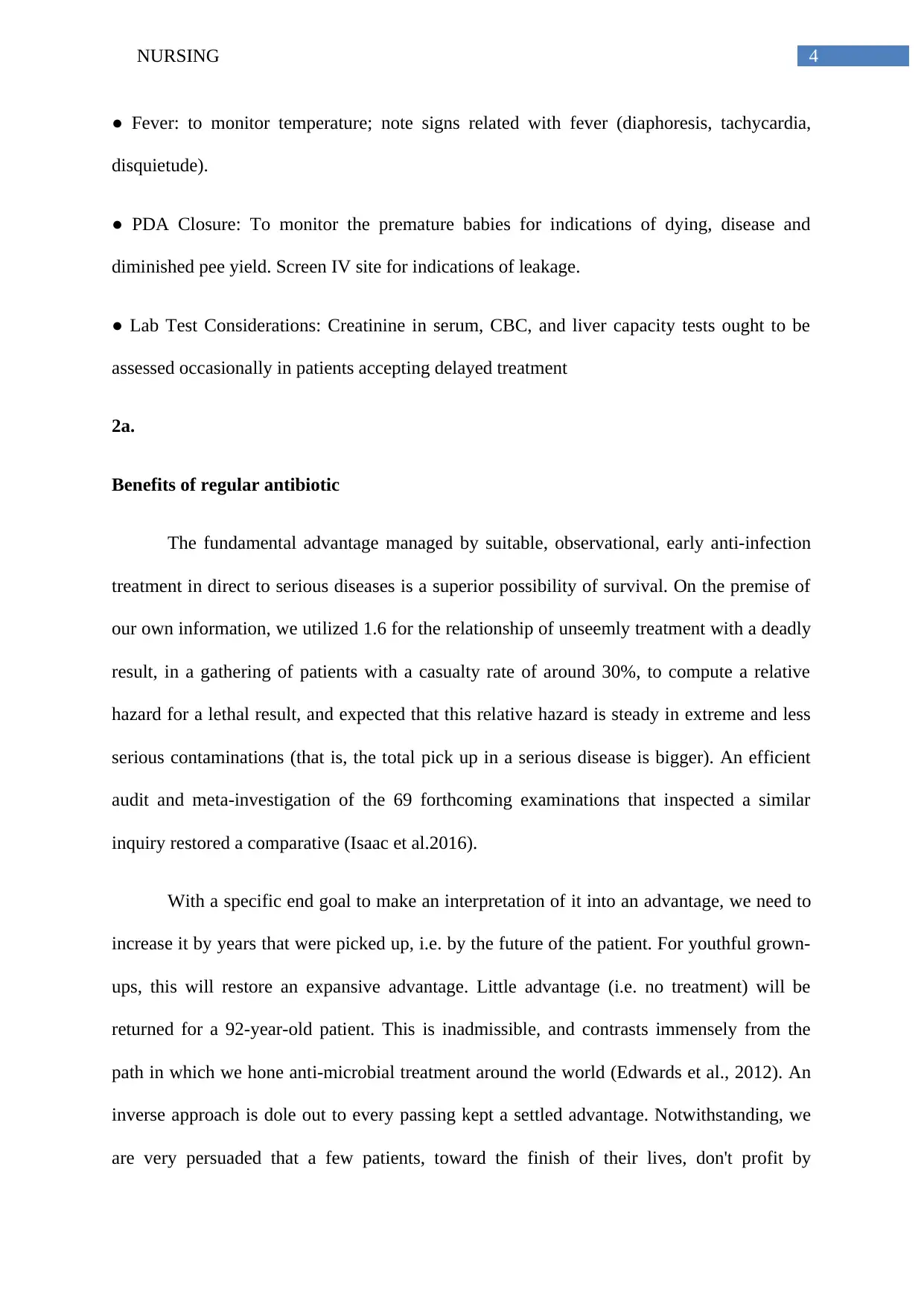
4NURSING
● Fever: to monitor temperature; note signs related with fever (diaphoresis, tachycardia,
disquietude).
● PDA Closure: To monitor the premature babies for indications of dying, disease and
diminished pee yield. Screen IV site for indications of leakage.
● Lab Test Considerations: Creatinine in serum, CBC, and liver capacity tests ought to be
assessed occasionally in patients accepting delayed treatment
2a.
Benefits of regular antibiotic
The fundamental advantage managed by suitable, observational, early anti-infection
treatment in direct to serious diseases is a superior possibility of survival. On the premise of
our own information, we utilized 1.6 for the relationship of unseemly treatment with a deadly
result, in a gathering of patients with a casualty rate of around 30%, to compute a relative
hazard for a lethal result, and expected that this relative hazard is steady in extreme and less
serious contaminations (that is, the total pick up in a serious disease is bigger). An efficient
audit and meta-investigation of the 69 forthcoming examinations that inspected a similar
inquiry restored a comparative (Isaac et al.2016).
With a specific end goal to make an interpretation of it into an advantage, we need to
increase it by years that were picked up, i.e. by the future of the patient. For youthful grown-
ups, this will restore an expansive advantage. Little advantage (i.e. no treatment) will be
returned for a 92-year-old patient. This is inadmissible, and contrasts immensely from the
path in which we hone anti-microbial treatment around the world (Edwards et al., 2012). An
inverse approach is dole out to every passing kept a settled advantage. Notwithstanding, we
are very persuaded that a few patients, toward the finish of their lives, don't profit by
● Fever: to monitor temperature; note signs related with fever (diaphoresis, tachycardia,
disquietude).
● PDA Closure: To monitor the premature babies for indications of dying, disease and
diminished pee yield. Screen IV site for indications of leakage.
● Lab Test Considerations: Creatinine in serum, CBC, and liver capacity tests ought to be
assessed occasionally in patients accepting delayed treatment
2a.
Benefits of regular antibiotic
The fundamental advantage managed by suitable, observational, early anti-infection
treatment in direct to serious diseases is a superior possibility of survival. On the premise of
our own information, we utilized 1.6 for the relationship of unseemly treatment with a deadly
result, in a gathering of patients with a casualty rate of around 30%, to compute a relative
hazard for a lethal result, and expected that this relative hazard is steady in extreme and less
serious contaminations (that is, the total pick up in a serious disease is bigger). An efficient
audit and meta-investigation of the 69 forthcoming examinations that inspected a similar
inquiry restored a comparative (Isaac et al.2016).
With a specific end goal to make an interpretation of it into an advantage, we need to
increase it by years that were picked up, i.e. by the future of the patient. For youthful grown-
ups, this will restore an expansive advantage. Little advantage (i.e. no treatment) will be
returned for a 92-year-old patient. This is inadmissible, and contrasts immensely from the
path in which we hone anti-microbial treatment around the world (Edwards et al., 2012). An
inverse approach is dole out to every passing kept a settled advantage. Notwithstanding, we
are very persuaded that a few patients, toward the finish of their lives, don't profit by
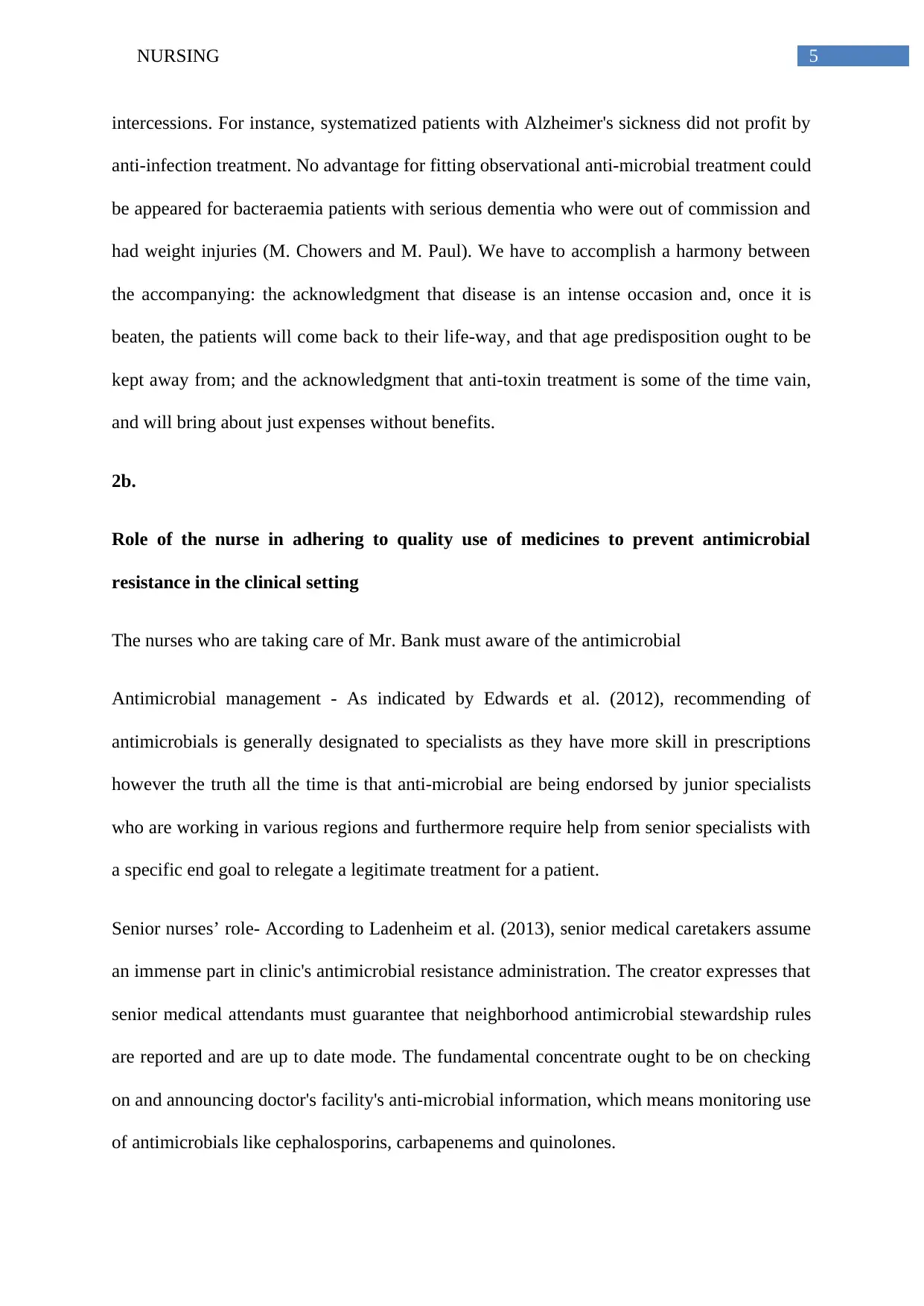
5NURSING
intercessions. For instance, systematized patients with Alzheimer's sickness did not profit by
anti-infection treatment. No advantage for fitting observational anti-microbial treatment could
be appeared for bacteraemia patients with serious dementia who were out of commission and
had weight injuries (M. Chowers and M. Paul). We have to accomplish a harmony between
the accompanying: the acknowledgment that disease is an intense occasion and, once it is
beaten, the patients will come back to their life-way, and that age predisposition ought to be
kept away from; and the acknowledgment that anti-toxin treatment is some of the time vain,
and will bring about just expenses without benefits.
2b.
Role of the nurse in adhering to quality use of medicines to prevent antimicrobial
resistance in the clinical setting
The nurses who are taking care of Mr. Bank must aware of the antimicrobial
Antimicrobial management - As indicated by Edwards et al. (2012), recommending of
antimicrobials is generally designated to specialists as they have more skill in prescriptions
however the truth all the time is that anti-microbial are being endorsed by junior specialists
who are working in various regions and furthermore require help from senior specialists with
a specific end goal to relegate a legitimate treatment for a patient.
Senior nurses’ role- According to Ladenheim et al. (2013), senior medical caretakers assume
an immense part in clinic's antimicrobial resistance administration. The creator expresses that
senior medical attendants must guarantee that neighborhood antimicrobial stewardship rules
are reported and are up to date mode. The fundamental concentrate ought to be on checking
on and announcing doctor's facility's anti-microbial information, which means monitoring use
of antimicrobials like cephalosporins, carbapenems and quinolones.
intercessions. For instance, systematized patients with Alzheimer's sickness did not profit by
anti-infection treatment. No advantage for fitting observational anti-microbial treatment could
be appeared for bacteraemia patients with serious dementia who were out of commission and
had weight injuries (M. Chowers and M. Paul). We have to accomplish a harmony between
the accompanying: the acknowledgment that disease is an intense occasion and, once it is
beaten, the patients will come back to their life-way, and that age predisposition ought to be
kept away from; and the acknowledgment that anti-toxin treatment is some of the time vain,
and will bring about just expenses without benefits.
2b.
Role of the nurse in adhering to quality use of medicines to prevent antimicrobial
resistance in the clinical setting
The nurses who are taking care of Mr. Bank must aware of the antimicrobial
Antimicrobial management - As indicated by Edwards et al. (2012), recommending of
antimicrobials is generally designated to specialists as they have more skill in prescriptions
however the truth all the time is that anti-microbial are being endorsed by junior specialists
who are working in various regions and furthermore require help from senior specialists with
a specific end goal to relegate a legitimate treatment for a patient.
Senior nurses’ role- According to Ladenheim et al. (2013), senior medical caretakers assume
an immense part in clinic's antimicrobial resistance administration. The creator expresses that
senior medical attendants must guarantee that neighborhood antimicrobial stewardship rules
are reported and are up to date mode. The fundamental concentrate ought to be on checking
on and announcing doctor's facility's anti-microbial information, which means monitoring use
of antimicrobials like cephalosporins, carbapenems and quinolones.
⊘ This is a preview!⊘
Do you want full access?
Subscribe today to unlock all pages.

Trusted by 1+ million students worldwide
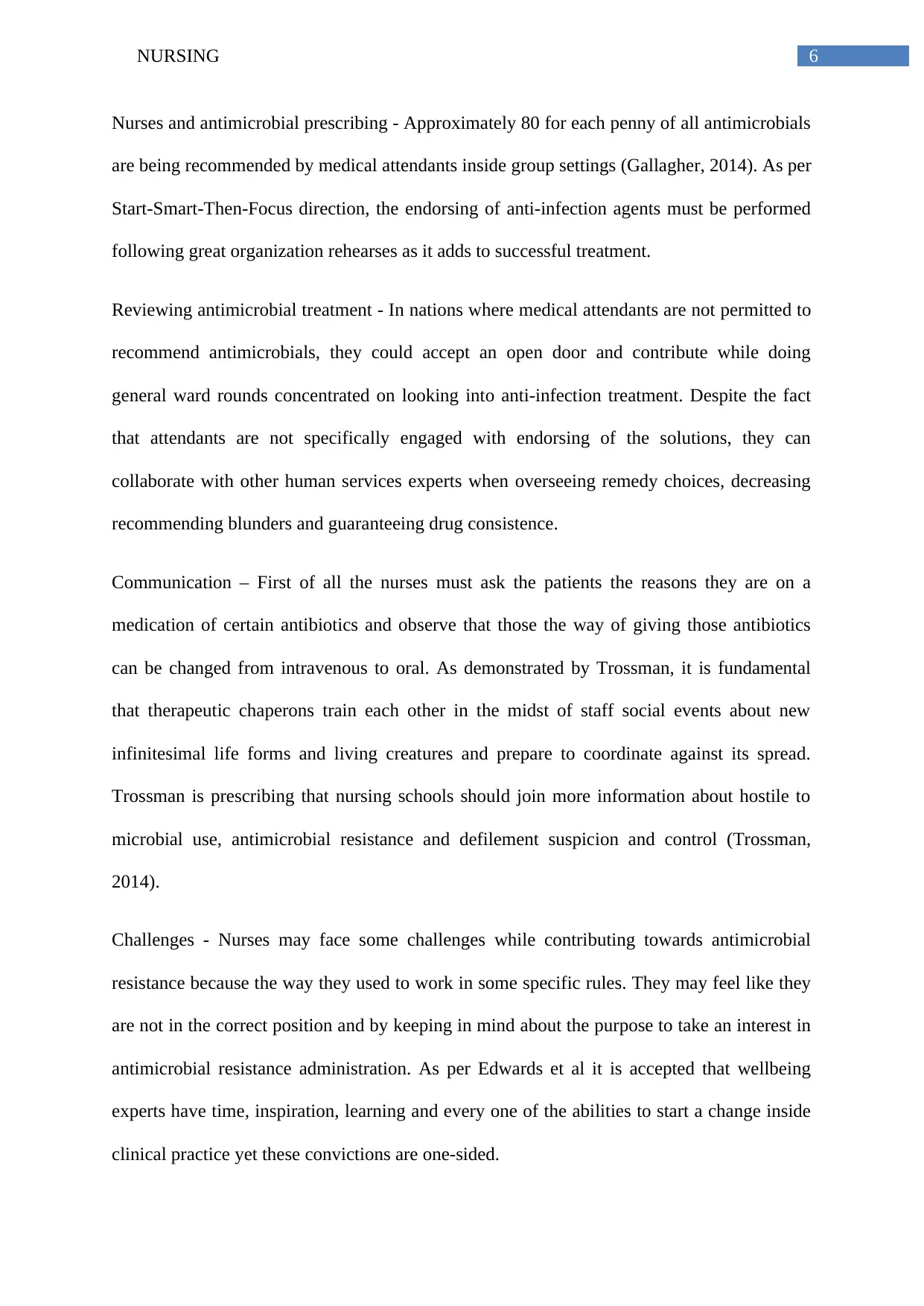
6NURSING
Nurses and antimicrobial prescribing - Approximately 80 for each penny of all antimicrobials
are being recommended by medical attendants inside group settings (Gallagher, 2014). As per
Start-Smart-Then-Focus direction, the endorsing of anti-infection agents must be performed
following great organization rehearses as it adds to successful treatment.
Reviewing antimicrobial treatment - In nations where medical attendants are not permitted to
recommend antimicrobials, they could accept an open door and contribute while doing
general ward rounds concentrated on looking into anti-infection treatment. Despite the fact
that attendants are not specifically engaged with endorsing of the solutions, they can
collaborate with other human services experts when overseeing remedy choices, decreasing
recommending blunders and guaranteeing drug consistence.
Communication – First of all the nurses must ask the patients the reasons they are on a
medication of certain antibiotics and observe that those the way of giving those antibiotics
can be changed from intravenous to oral. As demonstrated by Trossman, it is fundamental
that therapeutic chaperons train each other in the midst of staff social events about new
infinitesimal life forms and living creatures and prepare to coordinate against its spread.
Trossman is prescribing that nursing schools should join more information about hostile to
microbial use, antimicrobial resistance and defilement suspicion and control (Trossman,
2014).
Challenges - Nurses may face some challenges while contributing towards antimicrobial
resistance because the way they used to work in some specific rules. They may feel like they
are not in the correct position and by keeping in mind about the purpose to take an interest in
antimicrobial resistance administration. As per Edwards et al it is accepted that wellbeing
experts have time, inspiration, learning and every one of the abilities to start a change inside
clinical practice yet these convictions are one-sided.
Nurses and antimicrobial prescribing - Approximately 80 for each penny of all antimicrobials
are being recommended by medical attendants inside group settings (Gallagher, 2014). As per
Start-Smart-Then-Focus direction, the endorsing of anti-infection agents must be performed
following great organization rehearses as it adds to successful treatment.
Reviewing antimicrobial treatment - In nations where medical attendants are not permitted to
recommend antimicrobials, they could accept an open door and contribute while doing
general ward rounds concentrated on looking into anti-infection treatment. Despite the fact
that attendants are not specifically engaged with endorsing of the solutions, they can
collaborate with other human services experts when overseeing remedy choices, decreasing
recommending blunders and guaranteeing drug consistence.
Communication – First of all the nurses must ask the patients the reasons they are on a
medication of certain antibiotics and observe that those the way of giving those antibiotics
can be changed from intravenous to oral. As demonstrated by Trossman, it is fundamental
that therapeutic chaperons train each other in the midst of staff social events about new
infinitesimal life forms and living creatures and prepare to coordinate against its spread.
Trossman is prescribing that nursing schools should join more information about hostile to
microbial use, antimicrobial resistance and defilement suspicion and control (Trossman,
2014).
Challenges - Nurses may face some challenges while contributing towards antimicrobial
resistance because the way they used to work in some specific rules. They may feel like they
are not in the correct position and by keeping in mind about the purpose to take an interest in
antimicrobial resistance administration. As per Edwards et al it is accepted that wellbeing
experts have time, inspiration, learning and every one of the abilities to start a change inside
clinical practice yet these convictions are one-sided.
Paraphrase This Document
Need a fresh take? Get an instant paraphrase of this document with our AI Paraphraser
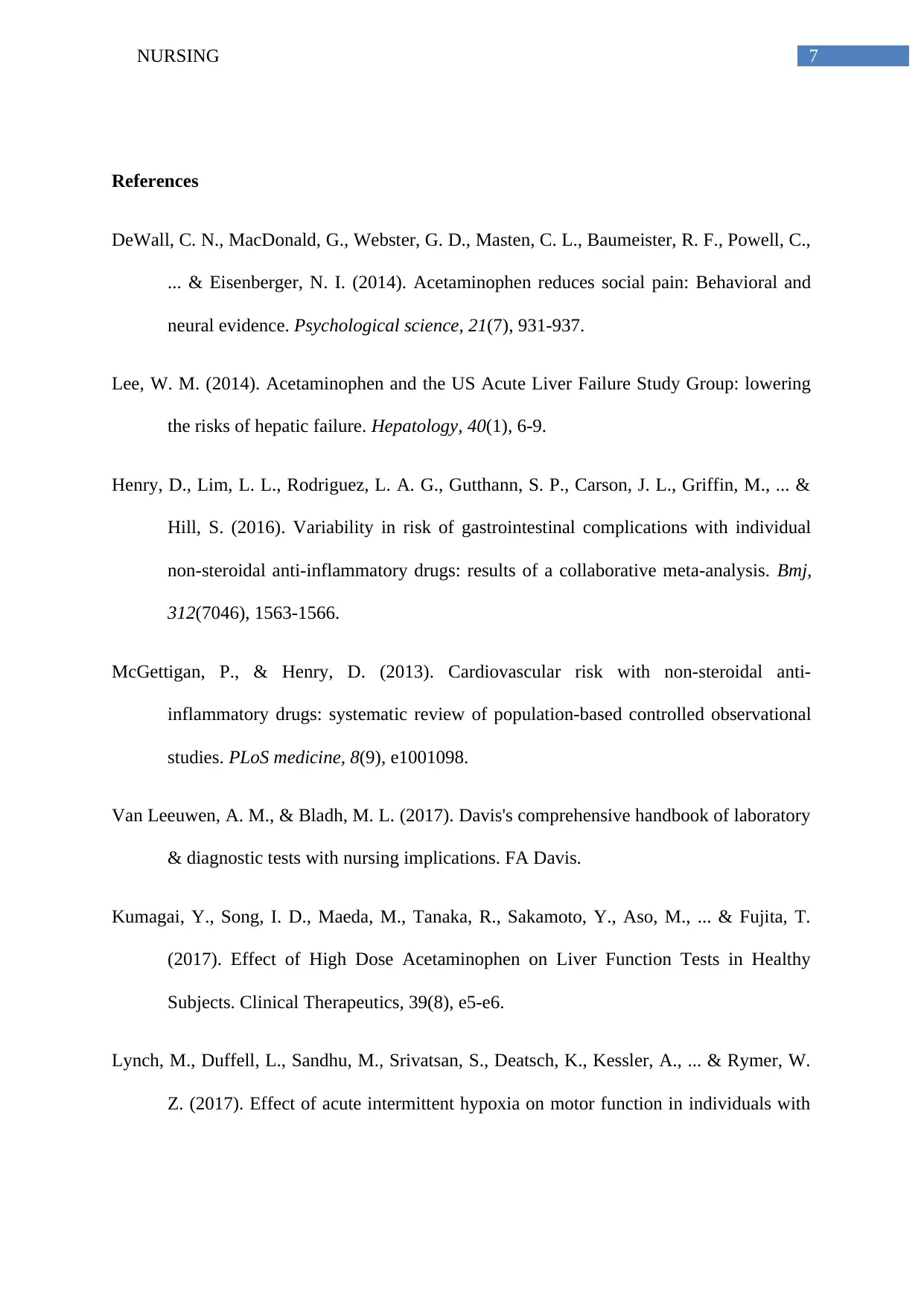
7NURSING
References
DeWall, C. N., MacDonald, G., Webster, G. D., Masten, C. L., Baumeister, R. F., Powell, C.,
... & Eisenberger, N. I. (2014). Acetaminophen reduces social pain: Behavioral and
neural evidence. Psychological science, 21(7), 931-937.
Lee, W. M. (2014). Acetaminophen and the US Acute Liver Failure Study Group: lowering
the risks of hepatic failure. Hepatology, 40(1), 6-9.
Henry, D., Lim, L. L., Rodriguez, L. A. G., Gutthann, S. P., Carson, J. L., Griffin, M., ... &
Hill, S. (2016). Variability in risk of gastrointestinal complications with individual
non-steroidal anti-inflammatory drugs: results of a collaborative meta-analysis. Bmj,
312(7046), 1563-1566.
McGettigan, P., & Henry, D. (2013). Cardiovascular risk with non-steroidal anti-
inflammatory drugs: systematic review of population-based controlled observational
studies. PLoS medicine, 8(9), e1001098.
Van Leeuwen, A. M., & Bladh, M. L. (2017). Davis's comprehensive handbook of laboratory
& diagnostic tests with nursing implications. FA Davis.
Kumagai, Y., Song, I. D., Maeda, M., Tanaka, R., Sakamoto, Y., Aso, M., ... & Fujita, T.
(2017). Effect of High Dose Acetaminophen on Liver Function Tests in Healthy
Subjects. Clinical Therapeutics, 39(8), e5-e6.
Lynch, M., Duffell, L., Sandhu, M., Srivatsan, S., Deatsch, K., Kessler, A., ... & Rymer, W.
Z. (2017). Effect of acute intermittent hypoxia on motor function in individuals with
References
DeWall, C. N., MacDonald, G., Webster, G. D., Masten, C. L., Baumeister, R. F., Powell, C.,
... & Eisenberger, N. I. (2014). Acetaminophen reduces social pain: Behavioral and
neural evidence. Psychological science, 21(7), 931-937.
Lee, W. M. (2014). Acetaminophen and the US Acute Liver Failure Study Group: lowering
the risks of hepatic failure. Hepatology, 40(1), 6-9.
Henry, D., Lim, L. L., Rodriguez, L. A. G., Gutthann, S. P., Carson, J. L., Griffin, M., ... &
Hill, S. (2016). Variability in risk of gastrointestinal complications with individual
non-steroidal anti-inflammatory drugs: results of a collaborative meta-analysis. Bmj,
312(7046), 1563-1566.
McGettigan, P., & Henry, D. (2013). Cardiovascular risk with non-steroidal anti-
inflammatory drugs: systematic review of population-based controlled observational
studies. PLoS medicine, 8(9), e1001098.
Van Leeuwen, A. M., & Bladh, M. L. (2017). Davis's comprehensive handbook of laboratory
& diagnostic tests with nursing implications. FA Davis.
Kumagai, Y., Song, I. D., Maeda, M., Tanaka, R., Sakamoto, Y., Aso, M., ... & Fujita, T.
(2017). Effect of High Dose Acetaminophen on Liver Function Tests in Healthy
Subjects. Clinical Therapeutics, 39(8), e5-e6.
Lynch, M., Duffell, L., Sandhu, M., Srivatsan, S., Deatsch, K., Kessler, A., ... & Rymer, W.
Z. (2017). Effect of acute intermittent hypoxia on motor function in individuals with
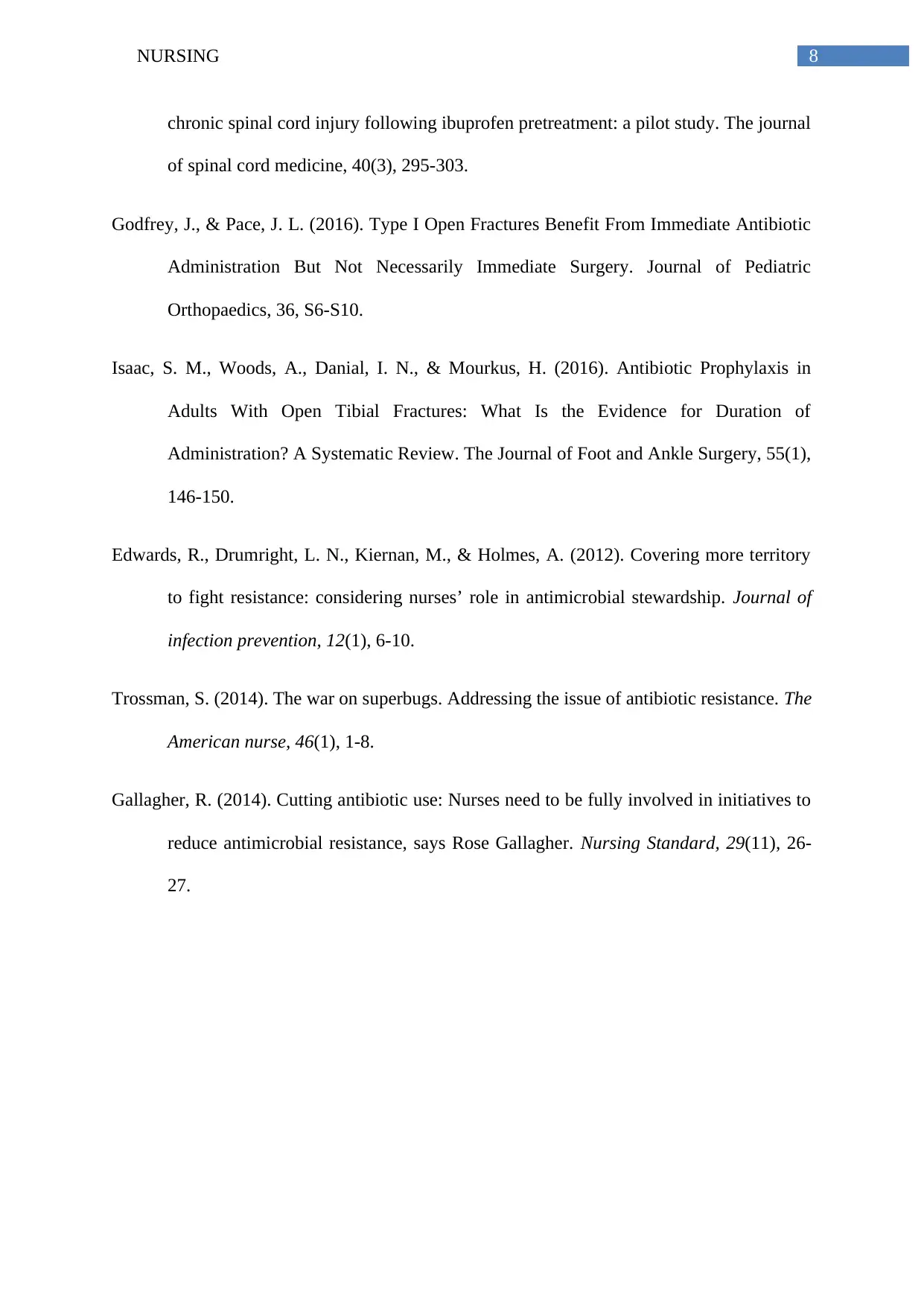
8NURSING
chronic spinal cord injury following ibuprofen pretreatment: a pilot study. The journal
of spinal cord medicine, 40(3), 295-303.
Godfrey, J., & Pace, J. L. (2016). Type I Open Fractures Benefit From Immediate Antibiotic
Administration But Not Necessarily Immediate Surgery. Journal of Pediatric
Orthopaedics, 36, S6-S10.
Isaac, S. M., Woods, A., Danial, I. N., & Mourkus, H. (2016). Antibiotic Prophylaxis in
Adults With Open Tibial Fractures: What Is the Evidence for Duration of
Administration? A Systematic Review. The Journal of Foot and Ankle Surgery, 55(1),
146-150.
Edwards, R., Drumright, L. N., Kiernan, M., & Holmes, A. (2012). Covering more territory
to fight resistance: considering nurses’ role in antimicrobial stewardship. Journal of
infection prevention, 12(1), 6-10.
Trossman, S. (2014). The war on superbugs. Addressing the issue of antibiotic resistance. The
American nurse, 46(1), 1-8.
Gallagher, R. (2014). Cutting antibiotic use: Nurses need to be fully involved in initiatives to
reduce antimicrobial resistance, says Rose Gallagher. Nursing Standard, 29(11), 26-
27.
chronic spinal cord injury following ibuprofen pretreatment: a pilot study. The journal
of spinal cord medicine, 40(3), 295-303.
Godfrey, J., & Pace, J. L. (2016). Type I Open Fractures Benefit From Immediate Antibiotic
Administration But Not Necessarily Immediate Surgery. Journal of Pediatric
Orthopaedics, 36, S6-S10.
Isaac, S. M., Woods, A., Danial, I. N., & Mourkus, H. (2016). Antibiotic Prophylaxis in
Adults With Open Tibial Fractures: What Is the Evidence for Duration of
Administration? A Systematic Review. The Journal of Foot and Ankle Surgery, 55(1),
146-150.
Edwards, R., Drumright, L. N., Kiernan, M., & Holmes, A. (2012). Covering more territory
to fight resistance: considering nurses’ role in antimicrobial stewardship. Journal of
infection prevention, 12(1), 6-10.
Trossman, S. (2014). The war on superbugs. Addressing the issue of antibiotic resistance. The
American nurse, 46(1), 1-8.
Gallagher, R. (2014). Cutting antibiotic use: Nurses need to be fully involved in initiatives to
reduce antimicrobial resistance, says Rose Gallagher. Nursing Standard, 29(11), 26-
27.
⊘ This is a preview!⊘
Do you want full access?
Subscribe today to unlock all pages.

Trusted by 1+ million students worldwide
1 out of 9
Your All-in-One AI-Powered Toolkit for Academic Success.
+13062052269
info@desklib.com
Available 24*7 on WhatsApp / Email
![[object Object]](/_next/static/media/star-bottom.7253800d.svg)
Unlock your academic potential
Copyright © 2020–2025 A2Z Services. All Rights Reserved. Developed and managed by ZUCOL.


